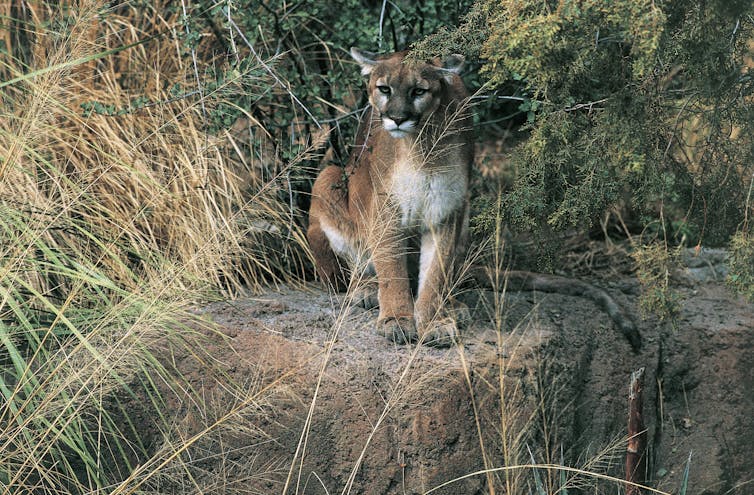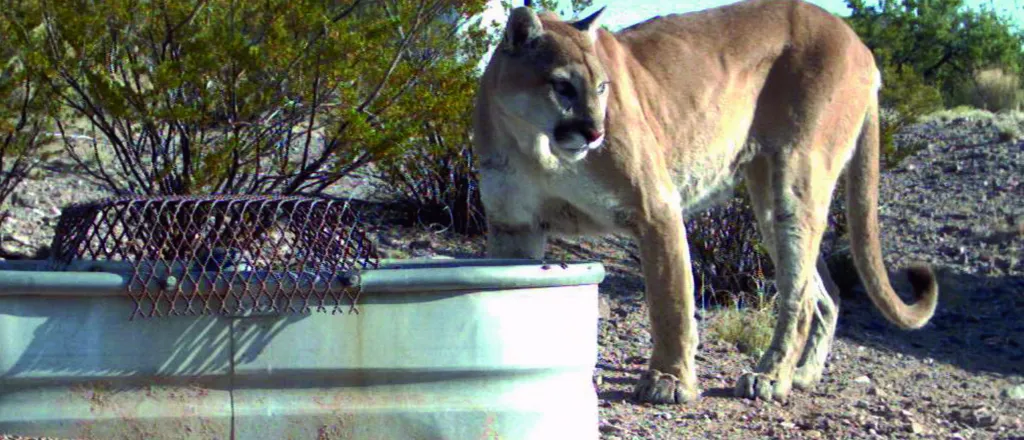
Hunting large carnivores is a contentious issue in wildlife management and conservation. It’s on the ballot in fall 2024 in Colorado, where voters will consider Initiative 91, a proposed ban on hunting and trapping of mountain lions, bobcats and lynx in the state.
Wildlife agencies often use regulated hunting as a tool for controlling carnivore populations, reducing their impacts on vulnerable wildlife or minimizing the risk of conflict between carnivores and people, pets and livestock. But scientific studies have questioned how effectively recreational hunting achieves these goals. And public attitudes are shifting as participation in hunting declines.
We direct Colorado State University’s Center for Human-Carnivore Coexistence and Animal-Human Policy Center. Together with our colleague Benjamin Ghasemi, we recently surveyed Colorado residents about their perceptions of hunting mountain lions and black bears in the state.
We found that support for hunting depended on the purpose, with most Coloradans disapproving of hunting for trophies or sport. Gender, age and other demographic factors also played roles.
Meet the neighbors
Mountain lions, also known as cougars or pumas, live primarily in the western U.S. and are legally hunted in all western states except California. Black bears, which live mainly in mountainous and forested regions across the continental U.S., are hunted in the majority of states in which they are found.
The Colorado Parks and Wildlife agency estimates that roughly 3,800 to 4,400 adult mountain lions and 17,000 to 20,000 black bears live in Colorado. They are found mainly in the Rocky Mountains, with the eastern edges of their ranges near more human-populated areas in the Front Range.
According to state data, hunters in Colorado killed 502 mountain lions during the 2022-2023 hunting season and 1,299 black bears during the 2023 season.
Both species come into conflict with people in the state. The most common situation is when bears wander into mountain towns in search of garbage or other foods left by humans. Mountain lions are occasionally sighted in urban areas, and on rare occasions have attacked people.
Varying views of hunting
Our study gathered responses from Colorado residents through two public mail surveys. Samples were weighted to be representative of state population demographics, including age, gender, urbanization level, geographical region and participation in hunting.
Respondents’ views on legal and regulated hunting of mountain lions were evenly split, with 41% approving and 41% disapproving. This was also true for black bears: 46% approved of hunting them, and 46% disapproved.
Large majorities disapproved of hunting either animal for trophies, hide or fur, or for recreation. For mountain lions, 78% of respondents disapproved of trophy hunting; for black bears, 86% disapproved of trophy hunting. People also generally disapproved of hunting either species for meat.
Respondents were more supportive of hunts for other reasons. They approved of hunting mountain lions and black bears to protect human safety by 63% and 57%, respectively. And 56% approved of hunting mountain lions to reduce harm to livestock.
Large majorities disapproved of hunting mountain lions with dogs (88%) or recorded electronic calls (75%). Most mountain lions hunted in Colorado are legally taken with the aid of dogs, which chase and then tree or corner the cats. Using electronic calls to attract the cats was permitted in some parts of western Colorado until 2024, when the practice was banned for hunting mountain lions. It remains legal for hunting other carnivores, such as bobcats and coyotes.
Women, younger people, urban residents and people who identified as or leaned Democratic tended to be less supportive of hunting than men, older people, rural residents and Republicans. A study we published in 2022 on the reintroduction of wolves to Colorado found a similar political split, with stronger support for restoring wolves among people who identified as Democratic than among Republicans.
How to coexist with carnivores?
Although Coloradans were generally supportive of using hunting to reduce human conflict with black bears and mountain lions, studies suggest that it might not be the most effective tool to do so.
For example, a recent experimental study in Ontario, Canada, concluded that increased hunting of black bears did not result in less conflict – particularly during years when the bear’s natural food sources, such as nuts and berries, were limited in the wild. A long-term study on bears in Durango, Colorado, also found that availability of natural foods in the wild, and the lure of human food within the city, were the main drivers of clashes with bears.
Conversely, another study in New Jersey – which is more densely developed than Colorado, so bears may be more likely to encounter people – found that well-regulated hunting of closely monitored black bear populations could help reduce conflict.
Similar to its policy with bears, Colorado uses hunting as a management tool for mountain lions. There is limited scientific evidence that hunting mountain lions may prevent conflict with them. A recent study found that juvenile mountain lions from a hunted site in Nevada tended to avoid developed areas. In contrast, young cats from a site in California without hunting did not show any preference for or against areas with people.
Yet, other correlative studies in Washington, California and Canada have suggested that hunting may make the problem worse. According to these researchers, hunting might disrupt the social dynamics and age structure of mountain lion populations, causing young cats seeking new territory to roam into populated areas, increasing their chances of encountering people.
Overall, we believe that more reliable scientific information is needed to guide carnivore management and test assumptions about how effective hunting is at addressing these problems. Continued focus on proactive, nonlethal strategies to prevent conflict is essential.
Ultimately, promoting coexistence between humans and carnivores is often much more about managing people than about managing predators. Changing human behavior is key.
For example, failing to store garbage securely attracts bears. So does filling bird feeders in spring, summer and fall, when bears are active. Steps to reduce encounters with mountain lions include hiking in groups and making noise; keeping dogs leashed in the backcountry; keeping pets indoors at home; and not landscaping with plants that attract deer, the cat’s main prey.
Big cats on the ballot
Colorado’s Initiative 91 would ban hunting and trapping of mountain lions, bobcats and lynx in the state. It would allow for lethal removal of problem animals to protect human life, property and livestock.
Hunting and trapping of bobcats, mainly to sell their pelts in the fur trade, is currently legal in Colorado. On average, hunters and trappers have killed 880 bobcats annually over the past three years, the majority of which were trapped. Hunting and trapping are currently prohibited for lynx, which are listed as endangered in Colorado and threatened nationally, but the proposed ban would protect them if their populations recover.
Coloradans have voted to limit carnivore hunting in the past. They passed a ballot initiative in 1992 to ban bait, hounds and a spring hunting season for bears, and another in 1996 to ban the use of leghold traps, poison and snares.
Our research adds to growing evidence that public views toward hunting and carnivores are shifting. An increasing share of Americans believes humans should coexist with carnivores and opposes lethal control for human benefit. Studies also suggest that ballot measures like Initiative 91 may become more common as public attitudes evolve and more diverse groups seek to influence wildlife management.
It will be challenging for wildlife managers to adapt to these changing values. Agencies may have to consider more participatory methods that engage diverse stakeholders in decision-making, develop new funding mechanisms that are less reliant on hunting and fishing license fees, and reexamine how and for whom they manage wild animals.![]()
Kevin Crooks, Professor of Fish, Wildlife, and Conservation Biology and Director, Center for Human-Carnivore Coexistence, Colorado State University and Rebecca Niemiec, Assistant Professor in the Human Dimensions of Natural Resources, Colorado State University
This article is republished from The Conversation under a Creative Commons license. Read the original article.


















